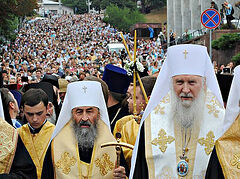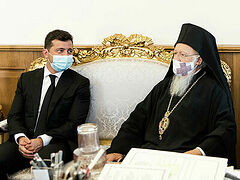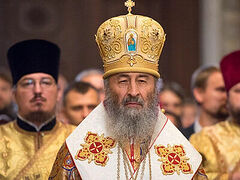The independent Ukrainian Orthodox Church has been persecuted in Ukraine since the time of Gorachev, who opened the doors to militant uniatism in Western Ukraine. From that time, backroom discussions began between Ukrainian presidents and Patriarch Bartholomew to establish autocephaly without Moscow. On the 1020th anniversary of the Baptism of Kievan Rus’, President Yushchenko of Ukraine tried to bring the schismatic Philaret to the service with the lawful Metropolitan of Kiev, Vladimir, Patriarch Alexiy II, and Patriarch Bartholomew. But the Lord did not allow that blasphemy to happen...
 Moleben on Vladimir Hill, July 27, 2008
Moleben on Vladimir Hill, July 27, 2008
—However, the authorities’ attempts to tailor autocephaly for their own uses did not stop…
—Absolutely correct. Viktor Baloga, the head of the presidential administration, together with the president’s brother Petro Yushchenko, was constantly going to Istanbul, holding backroom negotiations. And now, the second Maidan, “the revolution of dignity,” the invasion of Ukraine by American politicians, and Petro Poroshenko, finally implemented a project that is destructive for all of world Orthodoxy. Bartholomew, as they say, “ripened” under the affectionate wing of overseas patrons to commit a new schism in Ukraine, the likes of which hadn’t been seen for centuries. This situation is unacceptable, catastrophic—comparable only with the schism of a thousand years ago when Rome and Constantinople anathematized one another and parted forever, creating two completely different confessions.
By the way, I think it would be appropriate to recall 1997, when Patriarch Bartholomew went to Odessa to meet with Patriarchs Ilia II of Georgia and Alexiy II, and at the final conference dedicated to the visit, clearly and unequivocally declared that he recognizes the UOC with His Beatitude Vladimir as the sole canonical Church in Ukraine. Is this not clearly Jesuitism?!
—Thus, the modern policy of Istanbul contradicts itself.
—Moreover, it’s amoral. When Bartholomew says that “we are the Mother Church” and “we are concerned for our daughter Church,” we want to recall that time, more than 300 years ago, when the so-called “mother” sold its child for money,1 and this is an indisputable fact. It will always remain a most shameful stain in the life of Constantinople.
Constantinople’s mistake, or more precisely, its villainy is obvious: Once again, they are deciding our faith without the people of God, basking in their own geopolitical interests, but not those of the faithful of Ukraine. All of these backdoor negotiations with the participation of Poroshenko and secret visits to the Phanar by Ukrainian politicians look like a betrayal of the multi-million Orthodox flock.
When the so-called “unification council” was held at St. Sophia’s in Kiev with the proclamation of Bartholomew’s tomos, everything was veiled in the greatest of secrecy; everything all around was cordoned off by the police and special services, and all the participants in this lawless deed behaved like thieves in the night… A shameful action… It is clear to a simple babushka, and even to the not-very-informed Church youth, not mention those of the older generations, where is truth and where is a lie. And the people, Orthodox society, the people of God will defend the truth and protect their faith and their holy sites from the invasion of impostors and schismatics. And if necessary, they will lay down their lives.
Over these thirty years of existence, the UOC has proven that it is a great national force, in absolute unity with its primate, hierarchs, and monastics. It is a powerful, mighty monolith. The last cross procession in Kiev, which numbered 300,000 people, proves this.
—The holy fathers have said that if the Church as a whole and every believer in particular does not experience any difficulties, shocks, and temptations, it doesn’t contribute to spiritual growth. Can we can say that the Church becomes stronger due to such periods?
—Our Lord Jesus Christ preached for all the ages: Blessed are they which are persecuted for righteousness’ sake: for theirs is the Kingdom of Heaven (Mt. 5:10). On the one hand, trials associated with state policy, with the backdoor influence of foreign figures who try to run things in the Ukrainian land, which is foreign to them, are always painful and cause great harm. Some parishes, having a political orientation, have left us. His Beatitude Vladimir said that we always pray for our brothers who are in schism. He never tired of appealing to them with great love and fatherly exhortation to return to the bosom of the Mother Church.
And now, Metropolitan Onuphry appeals to the conscience of those who left the Church. These are wounds that our enemies, ill-wishers, or simply erring people inflict upon the body of the Church.
But, on the other hand, our Church can rightly be called a martyric Church. When I see footage of people in camouflage with Right Sector armbands, swearing and shouting, with rebar and weapons in hand, throwing bloodied elderly people out of churches, beating priests, cutting locks, kicking down church doors—in a word, rioting—my heart bleeds.
—Mother, but in times of trials, the Orthodox people are mobilized, illustrating unity and readiness to defend their holy sites. This is how it’s been for the whole thirty years of our independence.
—It’s enough to recall the All-Ukrainian cross procession in 2016, when Ukraine was burning with the fire of confrontations between east and west, and people were dying in the eastern part of the country. The cross procession demonstrated the true united faith of the inhabitants of eastern and western Ukraine, when the faithful from various regions of the country simultaneously left the Syvatogorsk Lavra in Donetsk and the Pochaev Lavra in Ternopil, with wonderworking icons, going out to meet each other.
 Hundreds of miles on foot—the elderly, the young, and children all marched
Hundreds of miles on foot—the elderly, the young, and children all marched
I remember the rabid verbal obstruction that crashed down on the Ukrainian Orthodox Church, its primate, and the participants in the procession. Our opponents had such hatred for our Church that they were ready to spill blood.
When the column reached Borsypil, the Minister of the Interior Arsen Avakov said grenades were found on the roadside—someone was planning a terrorist act. I saw footage of people from radical organizations throwing rocks at icons and crosses, throwing eggs, water bottles, and tearing icons from the hands of the processers. One of them seized a cross, and the people could barely get it back as the man raved and raged.
Never in the history of Ukraine has there been such a shame. On the contrary, the Cossacks of Ukraine defended the Church in battle, shedding their blood for it. The Zaporozhyians declared that they were protecting Orthodox holy sites. And then people who call themselves patriots of Ukraine, heirs of the glorious Cossacks, commit such atrocities—what reason and spirituality we can talk about here?!
And at the time when people from the west and east were processing towards one another, almost all the media, government representatives, representatives of the Cabinet of Ministers, representatives of the Presidential Administration, from the highest offices, declared it to be a “fifth column,” “enemies of Ukraine,” and so on.
I asked some of them: “Tell me, please, where these people are going? You say they’re the enemies of Ukraine. But where are they going? They are going to Kiev, to the capital of Ukraine, to unite east and west, to unite the parts of Ukraine that you have separated. So who are the enemies of Ukraine? Those who call for a schism along ethnic and linguistic lines, or those who, on the contrary, try to reunite Ukraine with the help of simple people?”
And these two cross processions, as well as many other processions from various dioceses of Ukraine, united into one grand procession on July 27, 2016, the eve of the feast of Prince Vladimir, the Baptizer of ancient Rus’.
I still have this picture before my eyes: a sea of people, with His Beatitude Metropolitan Onuphry standing in the center with his brothers, the archpastors, monastics, and dozens of wonderworking icons from all Ukrainian dioceses floating above the people along the central Kievan streets.
I would call this procession the pinnacle of the thirty years of the UOC. It was a great national prayer by believers from every province, every corner of Ukraine in its golden-domed capital, Kiev.
—There are testimonies of miraculous healings for people who risked everything to walk in the procession.
—We believe that the entire host of saints of ancient Rus’ and modern saints of our Church to whom we pray were present. Our Church is strong in its inextricable connection with the Heavenly Church. We see this by the miraculous events that have accompanied our flock over the course of the last three decades. Recall the 1990s: poverty, devastation, a lack of everything, and complete bewilderment for the majority of our citizens. And, in spite of this, how many beautiful churches were built and rebuilt? About 7,000 parishes were created!
In 2001, the Holy Dormition Cathedral of the Kiev Caves Lavra, built by St. Theodosius of the Caves—the greatest national holy site, blown up in 1941—was rebuilt. And again, it wasn’t without provocations. When President Leonid Kuchma and His Beatitude Metropolitan Vladimir went to the consecration of the cathedral, pseudo-patriot-nationalists staged mayhem, trying to prevent the event. Nevertheless, the sacred site was consecrated. Or the Holy Transfiguration Cathedral in Odessa—a masterpiece, recognized as a national treasure of Ukraine—was restored thanks to the help of the simple people and all the enterprises of the Odessa region. Or St. Vladimir’s Church in Chersonese, the site of the Baptism of Prince Vladimir; or the beautiful cathedral in Ternopil, where every single church was taken from us; or the magnificent new Holy Transfiguration Cathedral in the Pochaev Lavra—a miracle of light. Are these not testimonies of our faith and God’s help?!
 And, of course, the Church’s greatest and most important wealth is its people—every person, and those who have served and are serving for the good of the Church by their firmness in defending Orthodoxy, their wisdom in Church building, and their apostolic preaching. This includes hierarchs, clergy, monastics, and the numerous representatives of the people of God.
And, of course, the Church’s greatest and most important wealth is its people—every person, and those who have served and are serving for the good of the Church by their firmness in defending Orthodoxy, their wisdom in Church building, and their apostolic preaching. This includes hierarchs, clergy, monastics, and the numerous representatives of the people of God.
Remembering the past, contemplating the present, you understand that the strength of Ukraine is its Orthodox faith!
—Mother Seraphima, you have spoken with His Holiness Patriarch Kirill many times. What are you most vivid impressions from these conversations?
—Having just taken up the difficult cross of the primatial ministry, His Holiness Patriarch Kirill’s first visit abroad was to Ukraine, in 2009. As a member of the working group that was created to quickly resolve the issues that arose, I had the good fortune to accompany him all around Ukraine. We went to Kiev, Crimea, western Ukraine, Donetsk, Pochaev. Although there were provocations in Volyn and other western Ukrainian places—pickets on the roads with political placards; local authorities banning the technical provisions for His Holiness’ trip—the trip still took place.
I was late to meet him in Lutsk because of some obstacles on the road. The Patriarch’s car passed through earlier, but when they saw me, the dissatisfied demonstrators pounced on me with profanity and abuse. I walked calmly and smiled, nodding to the enraged faces, and if not for the corridor of police, I would have been torn to pieces—such hatred was boiling in this crowd. Then I saw our faithful and Vladyka Niphont of Volyn, now reposed, who addressed the Orthodox parishioners [in Ukrainian]: “Children, are you glad that His Holiness the Patriarch has come to visit us? Welcome him!” And then the entire crowded square became excited, began to buzz, and began to chant: “Our Patriarch Holiness Kirill!” That’s how the people expressed their love for His Holiness.
I was struck by the fervent prayer with which His Holiness addressed God, asking for blessings and prosperity, grace and the help for the people of Ukraine and the Ukrainian Orthodox Church. He put his whole heart into this prayer, and I felt how concerned he was for our country. In the cities of Crimea, especially in Chersonese, at the site of the Baptism of Prince Vladimir, there was also a ton of people. People began walking at dawn to get to where His Holiness was serving. These were unforgettable moments, when we felt the presence of the Baptizer of Kievan Rus’ himself in this holy place.
Today, with the blessing of His Holiness, prayers are lifted up for Ukraine in every church of the ROC, and that’s not just in Russia, but in Belarus, in Kazakhstan, in Moldova—in sixty countries throughout the world. When we visited churches of Spain, Italy, Germany—everywhere, we heard how the parishioners pray for Ukraine. And at every service, His Holiness kneels and prays for the Ukrainian people, for peace in Ukraine. Who is our father? Who takes paternal care of us—the Patriarch from Istanbul, who wants to teach us with false insinuations from history? Or His Holiness Patriarch Kirill, whose love we actually feel? That’s a rhetorical question…
 Abbess Seraphima gives Patriarch Kirill a dove of peace, Lutsk, 2009 In the late 1990s, I came across an article in the chronicle of Philaret’s “Kiev Patriarchate” that was called “Why Should We Honor the Kazan Icon?” There were stupid ideas there: What does it have to do with Ukraine? It’s not our icon; we have to forget all these “Muscovite holy icons”! Venerated icons of the saints of Kievan Rus’, who labored and worked wonders on the “cursed land of Muscovy,” simply disappeared from their menaion. When politicians say: “Better satan than Moscow,” pray tell: Where is the end of this hatred? It is in the realm of hell… When hatred leads to the oblivion of the names of the great righteous ones, I want to ask: Do these people have any connection with Heaven? Alas, this is the tragedy of the deluded.
Abbess Seraphima gives Patriarch Kirill a dove of peace, Lutsk, 2009 In the late 1990s, I came across an article in the chronicle of Philaret’s “Kiev Patriarchate” that was called “Why Should We Honor the Kazan Icon?” There were stupid ideas there: What does it have to do with Ukraine? It’s not our icon; we have to forget all these “Muscovite holy icons”! Venerated icons of the saints of Kievan Rus’, who labored and worked wonders on the “cursed land of Muscovy,” simply disappeared from their menaion. When politicians say: “Better satan than Moscow,” pray tell: Where is the end of this hatred? It is in the realm of hell… When hatred leads to the oblivion of the names of the great righteous ones, I want to ask: Do these people have any connection with Heaven? Alas, this is the tragedy of the deluded.
And yet I want to believe that, as the Ecclesiast says, everything passes, and this will pass too. But the Lord abides forever (cf. Ps. 9:7) Amen.





